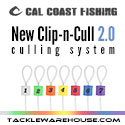 Casting: True to the results of our RoD WRACK, the Shabbler loads and casts very reminiscent of the F3-610DGS Aaron Martens Limited although it does not benefit from the eccentric first guide arrangement found on the F3-610DGS. While it is capable of handling baits down towards the lighter end of the rod's rating, I did not feel this was one of the rod's strengths. It seems much better suited for applications with lures down to about one-sixteenth (1/16) or even three-thirtysecondths (3/32) of an ounce. But of course, since it is a spinning rod, the castability of lighter offerings is easier to overcome than with a casting rod.
Casting: True to the results of our RoD WRACK, the Shabbler loads and casts very reminiscent of the F3-610DGS Aaron Martens Limited although it does not benefit from the eccentric first guide arrangement found on the F3-610DGS. While it is capable of handling baits down towards the lighter end of the rod's rating, I did not feel this was one of the rod's strengths. It seems much better suited for applications with lures down to about one-sixteenth (1/16) or even three-thirtysecondths (3/32) of an ounce. But of course, since it is a spinning rod, the castability of lighter offerings is easier to overcome than with a casting rod.
|

|
|
The entire carbon fiber sleeve at the base of the reel seat rotates as part of the reel seat's locking device
|
|

|
|
The top portion of the grip is a very refined cork
|
|

|
|
The very simple cap of Shabbler's handle assembly
|
Later, in our tests, I had the Shabbler paired with a Daiwa Exist 2004 spooled with about sixty yards of P-Line Floroclear. The weight savings from the Exist to the Certate Finesse was very noticeable and while overall performance of the rod was not really affected, I found it difficult to go back to the Certate Finesse. A lightweight spinning combo is a difficult luxury to overlook.
|

|
|
A look at Megabass's Stealth Fit spinning reel seat
|
|

|
|
The foot of your reel slides into that covered slot
|
|

|
|
and the locking divide moves up to hold your reel in place
|
Sensitivity: I've found, with most spinning rods, sensitivity is in direct proportion to the
flexibility of the rod's tip. Since the Shabbler has the least flexible tip out of this trio of rods, I expected it to be the least sensitive of the three and my theory proved to be true. While, in general, the rod is fairly good at transmitting information from the end of your line into your hands, at the end of the day, it suffers from following in my lineup behind the F3-610DGS. Still, in dragging a one-eighth ounce Spot Stalker jighead rigged with Yamamoto Hula Grub, it was very easy to discern bottom composition.





























